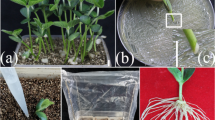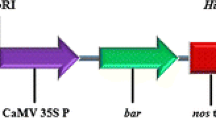Abstract
Agrobacterium rhizogenes-mediated transformation has become a powerful tool for studying gene function and root biology due to its quick and simple methodology. This transformation method is particularly suitable for those plants, including legumes, whose transformation using Agrobacterium tumefaciens has been challenging. Although there are some reports on A. rhizogenes-mediated transformation of legumes to produce ‘composite’ plants, conditions influencing A. rhizogenes-mediated transformation of soybean [Glycine max (L.) Merr.] have not been yet fully investigated. To better understand A. rhizogenes-mediated root transformation in soybean, we have evaluated the impact of genotype, plant age for infection, bacterial inoculating concentration, inoculation temperature, and other factors on transformation of soybean. The results have shown that there are significant differences among soybean genotypes in their susceptibility to A. rhizogenes. Soybean cv. Zigongdongdou is the most susceptible to A. rhizogenes strain K599 among 10 genotypes tested. The effects of seedling age have been evaluated, and 1-day-old plantlets are found to be optimal for hairy root induction. There are no significant differences in hairy root induction for bacterial suspension from OD600 = 0.2 to OD600 = 1.2. Under 16 h photoperiod, hairy roots can be induced both at 23°C/20°C and 28°C/25°C, but not at 33°C/30°C as day/night temperature regimes. Using this transformation protocol, almost 100% of the composite plants formed hairy roots within 2 weeks, and based on GUS histochemical analysis, 94.2% transformation frequency is obtained. Transgene integration has been also confirmed by Southern blot analysis.





Similar content being viewed by others
Abbreviations
- DAI:
-
Days of hairy root emergence after bacterial infection
References
Ane JM, Kiss GB, Riely BK et al (2004) Medicago truncatula DMI1 required for bacterial and fungal symbioses in legumes. Science 303:1364–1367. doi:10.1126/science.1092986
Banta LM, Bohne J, Lovejoy SD et al (1998) Stability of the Agrobacterium tumefaciens VirB10 protein is modulated by growth temperature and periplasmic osmoadaption. J Bacteriol 180:6597–6606
Baron C, Domke N, Beinhofer M et al (2001) Elevated temperature differentially affects virulence, VirB protein accumulation, and T-pilus formation in different Agrobacterium tumefaciens and Agrobacterium vitis strains. J Bacteriol 183:6852–6861. doi:10.1128/JB.183.23.6852-6861.2001
Bash R, Matthysse AG (2002) Attachment to roots and virulence of a chvB mutant of Agrobacterium tumefaciens are temperature sensitive. Mol Plant Microbe Interact 15:160–163. doi:10.1094/MPMI.2002.15.2.160
Bersoult A, Camut S, Perhald A et al (2005) Expression of the Medicago truncatula DMI2 gene suggests roles of the symbiotic nodulation receptor kinase in nodules and during early nodule development. Mol Plant Microbe Interact 18:869–876. doi:10.1094/MPMI-18-0869
Cheon CI, Lee N, Sissique A et al (1993) Roles of plant homologues of Rab1p and Rab7p in the bio-genesis of the peribacteroid membrane, a subcellular compartment formed de novo during root nodule symbiosis. EMBO J 12:4125–4135
Cho HJ, Wildholm JM (2002) Improved shoot regeneration protocol for hairy roots of legume Astragalus sincus. Plant Cell Tissue Organ Cult 69:259–269. doi:10.1023/A:1015624316573
Cho HJ, Farrand SK, Noel GR et al (2000) High-efficiency induction of soybean hairy roots and propagation of the soybean cyst nematode. Planta 210:195–204. doi:10.1007/PL00008126
Collier R, Fuchs B, Walter N et al (2005) Ex vitro composite plants: an inexpensive, rapid method for root biology. Plant J 43:449–457. doi:10.1111/j.1365-313X.2005.02454.x
Frendo P, Harrison J, Norman C et al (2005) Glutathione and homoglutathione play a critical role in the nodulation process of Medicago truncatula. Mol Plant Microbe Interact 18:254–259. doi:10.1094/MPMI-18-0254
Fujimoto Y, Ohyama K, Nomura K et al (2000) Biosynthesis of sterols and ecdysteroids in Ajuga hairy roots. Lipids 35:279–288. doi:10.1007/s11745-000-0524-z
Fullner KJ, Nester EW (1996) Temperature affects the T-DNA transfer machinery of Agrobacterium tumefaciens. J Bacteriol 178:1498–1504
Hansen AC, Busk H, Marcker A et al (1999) VsENBP1 regulates the expression of the early nodulin PsENOD12B. Plant Mol Biol 40:495–506. doi:10.1023/A:1006238303309
Hayashi S, Gresshoff PM, Kinkema M (2008) Molecular analysis of lipoxygenases associated with nodule development in soybean. Mol Plant Microbe Interact 21:843–853. doi:10.1094/MPMI-21-6-0843
Hinchee M, Connorward DV et al (1988) Production of transgenic soybean plants using Agrobacterium-mediated DNA transfer. Biotechnology (N Y) 6:915–922. doi:10.1038/nbt0888-915
Ivashuta S, Liu J, Liu J et al (2005) RNA interference identifies a calcium-dependent protein kinase involved in Medicago truncatula root development. Plant Cell 17:2911–2921. doi:10.1105/tpc.105.035394
Jefferson RA, Kavanagh TA, Bevan MW (1987) GUS-fusions: β-glucuronidase as a sensitive and versatile gene fusion marker in higher plants. EMBO J 6:3901–3907
Kaló P, Gleason C, Edwards A et al (2005) Nodulation signaling in legumes requires NSP2, a member of the GRAS family of transcriptional regulators. Science 308:1786–1789. doi:10.1126/science.1110951
Kereszt A, Li D, Indrasumunar A et al (2007) Agrobacterium rhizogenes-mediated transformation of soybean to study root biology. Nat Protoc 2:948–952. doi:10.1038/nprot.2007.141
Kuntal KN, Narayan B, Chaudhuri D et al (2006) Spontaneous plant regeneration in transformed roots and calli from Tylophora indica: changes in morphological phenotype and tylophorine accumulation associated with transformation by Agrobacterium rhizogenes. Plant Cell Rep 25:1059–1066. doi:10.1007/s00299-006-0164-z
Lee NG, Stein B, Suzuki H et al (1993) Expression of antisense nodulin-35 RNA in Vigna aconitifolia transgenic root nodules retards peroxisome development and affects nitrogen availability to the plant. Plant J 3:599–606. doi:10.1046/j.1365-313X.1993.03040599.x
Limpens E, Mirabella R, Fedorova E et al (2005) Formation of organelle-like N2-fixing symbiosomes in legume root nodules is controlled by DMI2. Proc Natl Acad Sci USA 102:10375–10380. doi:10.1073/pnas.0504284102
Lin BC, Kado CI (1977) Studies on Agrobacterium tumefaciens. VIII. Avirulence induced by temperature and ethidium bromide. Can J Microbiol 23:1554–1561
Lodhi AH, Bongaerts RJM, Verpoorte R et al (1996) Expression of bacterial isochorismate synthase in transgenic root cultures of Rubia peregrina. Plant Cell Rep 15:54–57. doi:10.1007/BF01275449
Moyano E, Jouhikainen K, Tammela P (2003) Effect of pmt gene overexpression on tropane alkaloid production in transformed root cultures of Datura metel and Hyoxcyamus muticus. J Exp Bot 54:203–211. doi:10.1093/jxb/54.381.203
Murray MG, Thompson WF (1980) Rapid isolation of high molecular weight plant DNA. Nucleic Acids Res 8:4321–4326. doi:10.1093/nar/8.19.4321
Olhoft PM, Flagel LE, Donovan CM et al (2003) Efficient soybean transformation using hygromycin B selection in the cotyledonary-node method. Planta 216:723–735
Paz M, Shou H, Guo Z et al (2004) Assessment of conditions affecting Agrobacterium-mediated soybean transformation using the cotyledonary node explants. Euphytica 136:167–179. doi:10.1023/B:EUPH.0000030670.36730.a4
Paz M, Carlos Martinez C, Kalvig AB et al (2005) Improved cotyledonary node method using an alternative explant derived from mature seed for efficient Agrobacterium-mediated soybean transformation. Plant Cell Rep 25:248–256. doi:10.1007/s00299-005-0113-2
Salas MG, Park SH, Srivatanakul M et al (2001) Temperature influence on stable T-DNA integration in plant cells. Plant Cell Rep 20:701–705. doi:10.1007/s002990100374
Savka MA, Ravillion B, Noel GR et al (1990) Induction of hairy roots on cultivated soybean genotypes and their use to propagate the soybean cyst nematode. Phytopathology 80:503–508. doi:10.1094/Phyto-80-503
Sevon N, Oksman C, Kirsi M (2002) Agrobacterium rhizogenes-mediated transformation: root cultures as a source of alkaloids. Planta Med 68:859–868. doi:10.1055/s-2002-34924
Taylor CG, Fuchs B, Collier R et al (2006) Generation of composite plants using Agrobacterium rhizogenes. Methods Mol Biol 343:155–167
Vickers CE, Schenk PM, Li D et al (2007) pGFPGUSPlus, a new binary vector for gene expression studies and optimising transformation systems in plants. Biotechnol Lett 29:1793–1796. doi:10.1007/s10529-007-9467-6
Vieweg MF, Hohnjec N, Küster H (2005) Two genes encoding different truncated hemoglobins are regulated during root nodule and arbuscular mycorrhiza symbioses of Medicago truncatula. Planta 220:757–766. doi:10.1007/s00425-004-1397-0
Xiao K, Zhang C, Harrison M et al (2005) Isolation and characterization of a novel plant promoter that directs strong constitutive expression of transgenes in plants. Mol Breed 15:221–231. doi:10.1007/s11032-004-5679-9
Zambre M, Terryn N, De Clercq J et al (2003) Light strongly promotes gene transfer from Agrobacterium tumefaciens to plant cells. Planta 216:580–586
Zeng P, Vadnais DA, Zhang Z et al (2004) Refined glufosinate selection in Agrobacterium-mediated transformation of soybean Glycine max (L.) Merrill. Plant Cell Rep 22:478–482. doi:10.1007/s00299-003-0712-8
Acknowledgments
The authors would like to thank: Professor Peter Gresshoff and Ms. Dongxue Li at University of Queensland, Australia, for providing A. rhizogenes strain K599 and vector pCAMBIAl305.1; Professor Sandui Guo for providing growth chambers and Yan Luo, Liang Li, Yang Yu, Jialin Wu, Xiaomin Ge for plant care; Dr. Zhanyuan J. Zhang for a critical review of this manuscript. This project was supported by the Special Fund for Routine Research of Central Public Welfare-oriented Institutions (072060302-18, 08206302-10), Natural Science Foundation of China (30771358) and National High Technology Research and Development Program of China (2007AA10Z133).
Author information
Authors and Affiliations
Corresponding author
Additional information
D. Cao and W. Hou contributed equally to this work.
Rights and permissions
About this article
Cite this article
Cao, D., Hou, W., Song, S. et al. Assessment of conditions affecting Agrobacterium rhizogenes-mediated transformation of soybean. Plant Cell Tiss Organ Cult 96, 45–52 (2009). https://doi.org/10.1007/s11240-008-9458-x
Received:
Accepted:
Published:
Issue Date:
DOI: https://doi.org/10.1007/s11240-008-9458-x




